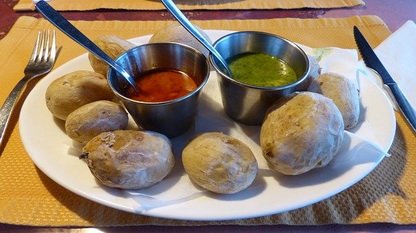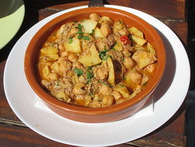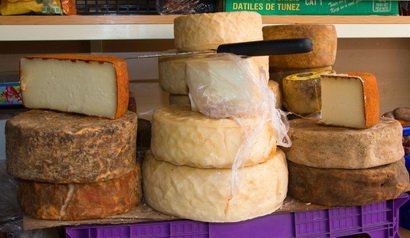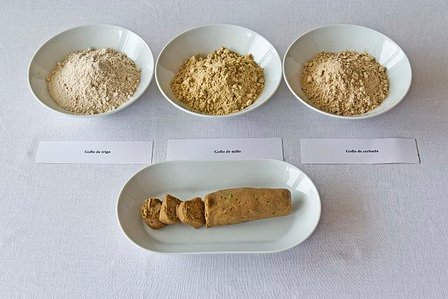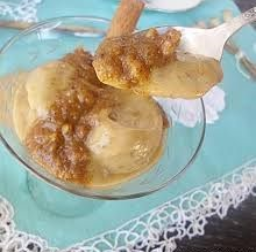To eat or not to eat… good question
What food should you try in the Canary islands
To eat or not to eat… what’s the answer?
Do we eat breakfast? – Papas arrugadas – Mojo picón – Fish – Soups – Queso – Gofio – Bienmesabe – Honey – Wine
C
anary Islands’ cuisine is a mixture of traditional Guanche food, Spanish favorites, and New World products.
The Islands were so far from the mainland, that their ecosystem was quite strict and rigid. People ate mostly vegetables and fish. The meat was an occasional and festive commodity. The Spaniards not only brought there their favorite products and dishes. They began the cultivation and realized that the ground is fertile! After all those years these products are called Canarian, but… The same can be told about the riches of the New World. The Islands were a welcomed stop before crossing the Atlantic. On the way back this was the first land that sailors saw. Imagine their happiness! It wasn’t easy to get them back on the ship.
Americas’ influence can be summed by this list: potatoes, beans, tomatoes, avocados, papaya, maize, cocoa, and tobacco. Bananas are also from the other side of the ocean, but now there exists a Canarian alteration that is much smaller and bulkier. Cocoa and tobacco, also foreign, brought riches to the islands.
And so, the base products of fish (fried, baked, sundried) and corn was enriched with everything else! Wonderful dishes emerged. Their main theme – fresh and simple. Which is a recipe for success! The meat that is the most popular comes from the animals that also allow making the cheese – goats, and sheep. They say it is the herb-marinated goat meat, which is apparently the tastiest (traditional X-mas meal).
Yes – you can eat the Spanish classics or maintain a healthy diet of fish and seafood, but why not spice it a little! This article will tell you more about the traditional, local dishes, so when you see them on the menu – you might be tempted to order just that.
How and when do they eat?
The breakfast is skipped, or it is just coffee with something sweet.
Oh… you cannot miss the quesadillas from El Hierro – gooey cinnamon rolls or cookie-cakes (in the photo) which can be eaten all the time!
And if somebody doesn’t like sweets – a toast is the answer. Lunch is a big meal, and it starts around 2 PM – it is liked to be shared among family and friends. The same goes for dinner, but they prefer to go to a tapas bar or a nice, local restaurant for a more private setting. It starts late and lasts long being the praeludium to the evening, weekend fun.
Papas arrugadas
Let’s take it out of the way – you are in a potato country. This cannot be denied. But the local patatas are something special. Remember that they grow on the rich, volcanic soil. They grow small and tasty and are the main ingredient of many dishes.
Patatas arrugadas can be called a signature dish! In the older times, potatoes were boiled in saltwater. No worries, they have finished with this practice. However, a rich amount of salt is still added to the water. The patatas are washed, the skin is not removed. There is a reason for both. When everything is ready and the water is out, the potatoes are left aside for the moment. This creates two distinctive features – the wrinkled skin and the salty residue on it.
The magic happens when you add mojo picón sauce and take a bite… and then another…
You can eat it as a separate dish or it can be an accompaniment to other ones – especially conejo al salmorejes, which translates to a rabbit (or chicken/pollo – marinated, cooked in wine, with a lot of herbs).
There is also a variation – papa negra which means black potatoes. What do you think about their color inside? They are said to be one of not many, pure, Canarian products. And if you don’t know how to answer – just try them and see for yourself 🙂
Mojo picón
Recipe link
Deserves a separate paragraph since there are no Canary Islands without it. Or so they say…
It is a sauce made of the beloved garlic, olive oil (often called Evoo), red or green pepper, cumin, salt, and vinegar. It is spicy, as the ingredients indicate, but there exist also a “verde” (green color from parsley and/or cilantro) and “suave” (mild) variations.
It is added to almost every dish in the Canary Islands, and you can know the restaurant by its mojo picón. They say that the one in Gran Canaria is one of the best, although nothing tastes like the homemade one.
You must also try the almogrote, which has its origins in La Gomera. It is a milder version made with leftover cheese. It is used as a spread over a slice of bread.
Important – make a nice, thick layer like the locals and devour it!
Fish
Sancocho canario recipe link
The Canary Islands make extensive use of local vegetables and fish! This is the staple of their cuisine. You do not really have dishes… the name of the fish is a dish.
Parrotfish (vieja) is very delicate in flavor. Wreckfish or grouper are bigger fish, with big flakes of meat. Mackerel has thick, creamy, full of Omega taste. Bass (cherne) tends to be grilled and crispy. If you don’t know which one to choose, look for parillada de pescado – a platter of different bites (often with some side veggies).
They like to serve them with some sides. Often – mojo picón or extra virgin olive oil (Evoo) is a must.
One of the most popular dishes they make is called Sancocho Canario. The idea was brought from the Americas but got a new life. In the Canary Islands, they serve like this: a cooked whole fish in the center, patatas arrugadas and mojo picón on the side (sometimes, there is gofio too). The fish – obviously, is the main actor of this simple, yet delicious meal.
Not to repeat ourselves with seafood… but what is fresh is the best! Some linguistic help though:
- chipirones (baby squid),
- pulpo frito (fried octopus),
- langostinos (prawns),
- mejillones (mussels),
- lapas (limpets)
- chocos (squid served whole, grilled-churred, served with spicy sauce)
Soups
Rancho canario recipe link
Puchero canario recipe link
Ropa vieja recipe link
Rancho canario is a soup, but the spoon can stand in it, so maybe it is a stew…? Thick noodles make it so, but there is also an abundance of meat, vegetable chunks, and chickpeas. It is so filling that it should be forbidden, but you want nothing else in the winter months.
Adding garlic is a must but putting some chorizo inside… gives this spicy sting you want! The Canarians make great chorizo. The most popular variation comes from Teror – no worries, it is a piece of a chewy sausage, but not terrifying at all.
If you want a milder, still very filling soup, try puchero canario (in the photo). There is a lot of tasty broth inside and chunks of meat, pumpkin, corn, cabbage, and sweet potatoes.
Ropa vieja?!
The ones knowing the Spanish language can be appalled now, but these are not old clothes served on a platter! The name probably comes from the fact, that this chickpea stew is made from leftovers. The main ingredients are potatoes, meat, onions, and chickpeas (in the photo). As a matter of fact, you can make many popular dishes out of those.
There is nothing better than the next day, put everything together and invent yet another version of ropa vieja. Why do we say so? Every time the leftovers are slightly different and in different quantities. And you can add whatever spices you feel like when you make it!
The locals cannot get bored with it.
Potaje de berros – it is a tasty stew-soup-broth… how to describe something with so many variations.
But the essentials – they make it from watercress greens, broth (vegetable or meat! – ask the waiter if it is important to you), chickpeas/beans. In a fuller version, it is served with some chunks of root vegetables inside.
Queso
There may not be enough space for big herds of cows, but goats and sheep are another stories. These two animals have a long history here, and so does the art of cheesemaking.
Queso de cabra is the local name for goat cheese and it comes with two, most popular names – Majorero and Palmero.
There is more though – queso herreño is the smoked variation.
Each cheese comes from a different island, Majorero for example was born on Fuerteventura. It has a museum there and its own label of DOC – proof of origin.
How do they prepare it? They like to make questo asado… sounds strange? Grilled cheese is the answer. It is a side dish that is often described in the menu as ración – a meal to share with friends.
Gofio
They say there is nothing more Canarian than Gofio, not even the famous spicy sauce is this high on the list.
It is a product made from grains cultivated back in the times of Guanches. It is sort of a superfood in here. People make all sorts of dishes out of it – starting with soups and finishing with desserts. It is a thickener, it is flour for bread, it is added to ice creams and they even make beer on it (Dorada Volcán from Tenerife).
It is an acquired taste (like wheat flakes) … Mixing it into other things helps though. Before, it was drunk with milk or cocoa every morning – “grow well and be healthy”! Maybe it is not as popular now, but it is still there and gaining popularity.
A safe choice is escaldon de gofio. It is a dip, often served with red onions or other veggies to scoop.
Bienmesabe
Recipe link
It is probably one of the most popular desserts in the Islands. It translates to “tastes good to me?” – as if you would need reassuring that you have a slice of heaven in your mouth.
It came from the Spanish mainland… and yes there are some Arabian traditions in it, BUT!
Gran Canaria has a lot of almond trees that are needed to make almond puree for this dessert. Then you add some yolk, sugar, lemon, and cinnamon… a touch of ice cream maybe? Why not! The main pudding is the most important, then you can taste it with everything else.
What is the best – if you add other ingredients and change the consistency you get… bienmesabe cake. How lucky is it.
It is a pure, Canarian experience.
Honey
Now that you know that the Canary Islands have almond trees, you will be glad to know that they also produce their own honey.
Of course – the difference comes with the flowers, so you can have different flavors.
The most recognizable, although its production differs, is the Palm Honey (of La Gomera). For more than three centuries the way of preparation seems to be the same. People climb the tree, cut the bark until they reach the sap. They burn it as it comes out and gathers it.
Because of the process, it is both sweet and toasted at the same time. The taste is so special and versatile that it is an ingredient used with sweets and fruits (try it with Canarian banana) but also with cheese and meats! The health benefits are multiple, so you can think about a souvenir.
And there is yet another special honey… it is the honey rum from the distillery in Tenerife. The Canary Islands are the land of wine, but which sailor would not use a glass of the golden nectar?
Wine and…
The volcanic soils do wonders to the vineyards and vines of the Canary Islands. They may not be local, but they adapted quite well.
Each island produces its own flavor and so you have a sweet Malmsey from Lanzarote which is accompanied by some traditional notes of Abona or El Hiero. There is La Palma, Monte Lentisol or Gran Canaria. There are whole valleys like Orotava or Icod-Dante-Isora. Some of them have even tasting places – like Acenteja Valle near Tacoronte.
Search for PDO letters on the bottle – this is the indication that it is a protected, Canarian product.
And if you do not like it – maybe you will prefer the local Banana Liqueur more.



